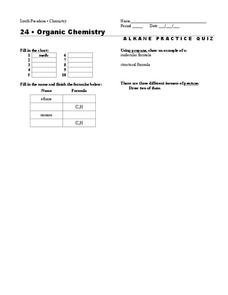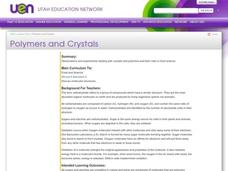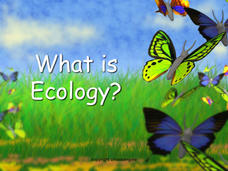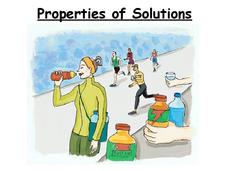Biology Junction
Macromolecules
In chemistry, organic means something contains a carbon base. A helpful presentation starts by defining macromolecules as large organic carbon molecules. Scholars answer questions about each topic on the associated worksheet. It covers...
Teach Engineering
Balancing Liquid on a Coin: How Intermolecular Forces Work
Let knowledge of chemistry flow like water. Future scientists conduct two different experiments to investigate the properties of water. They learn about surface tension and cohesion as they see how many drops of water they can place on a...
Curated OER
Organic Chemistry
In this organic chemistry worksheet, students fill in two charts with prefixes used for alkanes and the names and chemical formulas for different alkanes. They draw structural and chemical formulas for given organic compounds.
Curated OER
Grossmont College - Chem 116 Practice Exam 3
This biochemistry practice exam queries takers on the organic molecules. Pupils write IUPAC names, identify boiling and melting points of different compounds, and more. This is definitely designed for a college-level biochemistry course,...
Curated OER
Chemistry Unit on Compounds, Formulas, and Equations
Students perform a review assignment in 3 portions to review chemistry compounds, formulas, and equations. The assignment consists of several different portions that can be used as assessments. The majority of the lesson plan is composed...
Curated OER
Plastics Crossword
In this chemistry worksheet, students look for the solutions to the crossword puzzle that is based upon the topic of plastics. The sheet is helpful for vocabulary.
Curated OER
Polymers and Crystals: Their Role in Food Science
Blend chemistry with cooking in this exploration of polymers, carbohydrates, and food science. Experimenting with gelatin produces concrete examples of the bonding and ploymerization discussed in the lesson. Copious, comprehensive...
Curated OER
Geometric Isomerism (Different Geometries)
Here is an interactive presentation on molecular geometry if you have materials for building molecule models along the way. Isomerism is introduced by means of a graphic organizer. Viewers then imitate two molecule models and learn that...
Curated OER
Polymers all Over the Place
Students investigate properties of common molecules. In this chemistry instructional activity, students construct polymer models to gain a better understanding of the properties of polymers.
Curated OER
How Big is a Molecule?
Young scholars estimate the size of a molecule of oleic acid. They conduct an experiment using chalk dust, water, and oleic acid, solve various calculations, and answer discussion questions.
Curated OER
Organic Chemistry-Understanding Organic Reactions
For this organic reactions worksheet, high schoolers are given descriptions of the seven types of reaction of organic compounds. They then answer six questions about these reactions.
Biology Junction
What Is Ecology?
Do you know the name for the biological study of interactions? A short presentation with accompanying worksheet introduces individuals to ecology. The materials offer a broad overview of the subject and the levels of organization to...
Bellevue College
Practice Drawing Lewis Structures
Twenty-six elements, compounds, and ions are randomly listed for chemistry whizzes to analyze. They are to diagram the Lewis electron dot structure for each, resulting in further insight on the configuration of different molecules. They...
Curated OER
Organic Chemistry-Emphatically Aliphatic
In this aliphatic worksheet, students are given eight hydrocarbon molecules. They determine if they are alkanes, alkenes or alkynes. They draw a diagram of each and indicate if they are saturated or unsaturated.
Curated OER
Organic Chemistry-Naming Substituted Hydrocarbons
In this substituted hydrocarbons worksheet, students learn how to name compounds using a table of organic functional groups and the rules for naming hydrocarbon compounds. They practice naming twenty substituted hydrocarbons.
Curated OER
Sweet Science: How Sugar Molecules are Manipulated in Candy Making
Students investigate how heat affect sugar solutions. In this science lesson, students compare the sweetness of different types of sugars. They research the development of sugar and create a timeline.
Cornell University
The Making of Macromolecules
Compare and contrast macromolecules made from the same elements. Young scholars learn how the structure of a molecule has as much influence on a compound as the elements in the molecule. They experiment with molecular model kits to...
National Nanotechnology Infrastructure Network
Synthesis and Characterization of CdSe Quantum Dots
Does the size of a sample change the physical properties of that substance? It turns out it can! Young scientists combine physics and chemistry to synthesize CdSe quantum dots and record their color properties. Learners should notice a...
Curated OER
Exposure!
Students investigate that chemicals may affect different people in different ways. They also realize that their perceptions of dangerous materials may not be realistic and that the news media may not provide all the information needed to...
Cornell University
Electroplating
Silver pennies and copper nickels are made possible by applying some chemistry. Learners use electrolysis to coat a penny with zinc sulfate and a nickel with copper sulfate. Their investigation builds an understanding of electroplating...
Curated OER
Chemical Formulas
Students examine the structure of molecules, their formula, and percentage composition of each element in the compound. They construct an organic compound with different functional groups using a modeling kit, and draw a 3-D structure...
Curated OER
Molecular Modeling Activity
Students work together to explain the VSEPR theory and how it relates to molecules. They name electron pairs that can surround the central atom of an organism. They discuss the factors that determine the polarity of a molecule as well.
University of California
You Are What You Eat: Testing for Organic Compounds in Foods
We have all heard that we are what you eat, but what are we eating? An informative lesson opens with a discussion of the foods pupils have recently eaten. Then, young scientists perform four experiments on seven different foods to...
Science Geek
Properties of Solutions
Study the properties of solutions as they relate to mixtures. The slide show presents the key concepts involved with solutions including solvents, solutes, solubility, and electrolytes. Scholars learn the basics of the properties of...

























